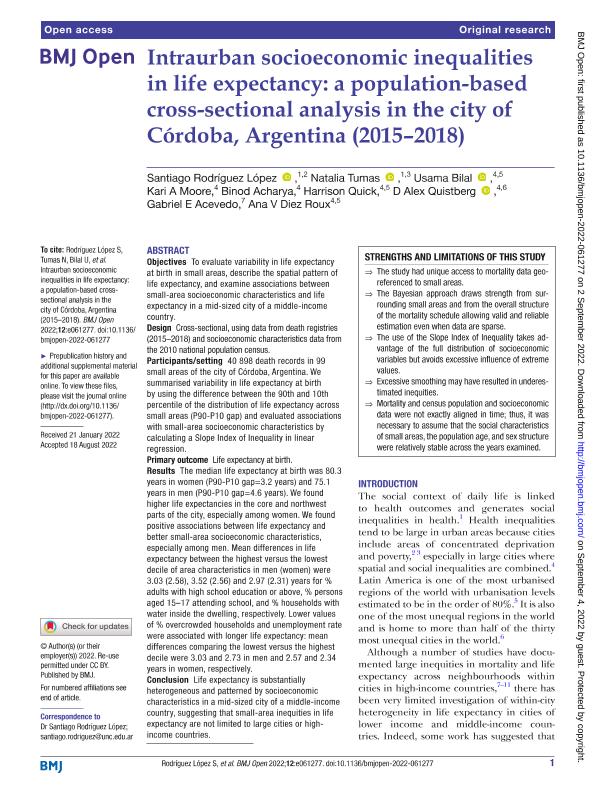Mostrar el registro sencillo del ítem
dc.contributor.author
Rodríguez López, Santiago

dc.contributor.author
Tumas, Natalia

dc.contributor.author
Bilal, Usama
dc.contributor.author
Moore, Kari A.
dc.contributor.author
Achayra, Binod
dc.contributor.author
Quick, Harrison
dc.contributor.author
Quistberg, Alex
dc.contributor.author
Acevedo, Gabriel Esteban

dc.contributor.author
Diez Roux, Ana Victoria

dc.date.available
2023-08-16T12:14:13Z
dc.date.issued
2022-08
dc.identifier.citation
Rodríguez López, Santiago; Tumas, Natalia; Bilal, Usama; Moore, Kari A.; Achayra, Binod; et al.; Intraurban socioeconomic inequalities in life expectancy: A population-based cross-sectional analysis in the city of Córdoba, Argentina (2015-2018); BMJ Publishing Group; BMJ Open; 12; 9; 8-2022; 1-8
dc.identifier.uri
http://hdl.handle.net/11336/208457
dc.description.abstract
Objectives To evaluate variability in life expectancy at birth in small areas, describe the spatial pattern of life expectancy, and examine associations between small-area socioeconomic characteristics and life expectancy in a mid-sized city of a middle-income country. Design Cross-sectional, using data from death registries (2015-2018) and socioeconomic characteristics data from the 2010 national population census. Participants/setting 40 898 death records in 99 small areas of the city of Córdoba, Argentina. We summarised variability in life expectancy at birth by using the difference between the 90th and 10th percentile of the distribution of life expectancy across small areas (P90-P10 gap) and evaluated associations with small-area socioeconomic characteristics by calculating a Slope Index of Inequality in linear regression. Primary outcome Life expectancy at birth. Results The median life expectancy at birth was 80.3 years in women (P90-P10 gap=3.2 years) and 75.1 years in men (P90-P10 gap=4.6 years). We found higher life expectancies in the core and northwest parts of the city, especially among women. We found positive associations between life expectancy and better small-area socioeconomic characteristics, especially among men. Mean differences in life expectancy between the highest versus the lowest decile of area characteristics in men (women) were 3.03 (2.58), 3.52 (2.56) and 2.97 (2.31) years for % adults with high school education or above, % persons aged 15-17 attending school, and % households with water inside the dwelling, respectively. Lower values of % overcrowded households and unemployment rate were associated with longer life expectancy: mean differences comparing the lowest versus the highest decile were 3.03 and 2.73 in men and 2.57 and 2.34 years in women, respectively. Conclusion Life expectancy is substantially heterogeneous and patterned by socioeconomic characteristics in a mid-sized city of a middle-income country, suggesting that small-area inequities in life expectancy are not limited to large cities or high-income countries.
dc.format
application/pdf
dc.language.iso
eng
dc.publisher
BMJ Publishing Group
dc.rights
info:eu-repo/semantics/openAccess
dc.rights.uri
https://creativecommons.org/licenses/by/2.5/ar/
dc.subject
LIFE EXPECTANCY
dc.subject
NEIGHBORHOODS
dc.subject
SMALL-AREA ESTIMATION
dc.subject
ARGENTINA
dc.subject
TOPALS
dc.subject
EPIDEMIOLOGY
dc.subject
SOCIAL MEDICINE
dc.subject
PUBLIC HEALTH
dc.subject.classification
Salud Pública y Medioambiental

dc.subject.classification
Ciencias de la Salud

dc.subject.classification
CIENCIAS MÉDICAS Y DE LA SALUD

dc.title
Intraurban socioeconomic inequalities in life expectancy: A population-based cross-sectional analysis in the city of Córdoba, Argentina (2015-2018)
dc.type
info:eu-repo/semantics/article
dc.type
info:ar-repo/semantics/artículo
dc.type
info:eu-repo/semantics/publishedVersion
dc.date.updated
2023-07-19T15:38:08Z
dc.identifier.eissn
2044-6055
dc.journal.volume
12
dc.journal.number
9
dc.journal.pagination
1-8
dc.journal.pais
Reino Unido

dc.journal.ciudad
Londres
dc.description.fil
Fil: Rodríguez López, Santiago. Consejo Nacional de Investigaciones Científicas y Técnicas. Centro Científico Tecnológico Conicet - Córdoba. Centro de Investigaciones y Estudios sobre Cultura y Sociedad. Universidad Nacional de Córdoba. Centro de Investigaciones y Estudios sobre Cultura y Sociedad; Argentina. Universidad Nacional de Córdoba. Facultad de Ciencias Exactas, Físicas y Naturales; Argentina
dc.description.fil
Fil: Tumas, Natalia. Universitat Pompeu Fabra. Departament de Ciències Polítiques I Socials; España. Consejo Nacional de Investigaciones Científicas y Técnicas. Centro Científico Tecnológico Conicet - Córdoba. Centro de Investigaciones y Estudios sobre Cultura y Sociedad. Universidad Nacional de Córdoba. Centro de Investigaciones y Estudios sobre Cultura y Sociedad; Argentina
dc.description.fil
Fil: Bilal, Usama. Drexel University; Estados Unidos
dc.description.fil
Fil: Moore, Kari A.. Drexel University; Estados Unidos
dc.description.fil
Fil: Achayra, Binod. Drexel University; Estados Unidos
dc.description.fil
Fil: Quick, Harrison. Drexel University; Estados Unidos
dc.description.fil
Fil: Quistberg, Alex. Drexel University; Estados Unidos
dc.description.fil
Fil: Acevedo, Gabriel Esteban. Universidad Nacional de Córdoba. Facultad de Medicina; Argentina
dc.description.fil
Fil: Diez Roux, Ana Victoria. Drexel University; Estados Unidos
dc.journal.title
BMJ Open
dc.relation.alternativeid
info:eu-repo/semantics/altIdentifier/url/https://bmjopen.bmj.com/content/12/9/e061277
dc.relation.alternativeid
info:eu-repo/semantics/altIdentifier/doi/http://dx.doi.org/10.1136/bmjopen-2022-061277
Archivos asociados
